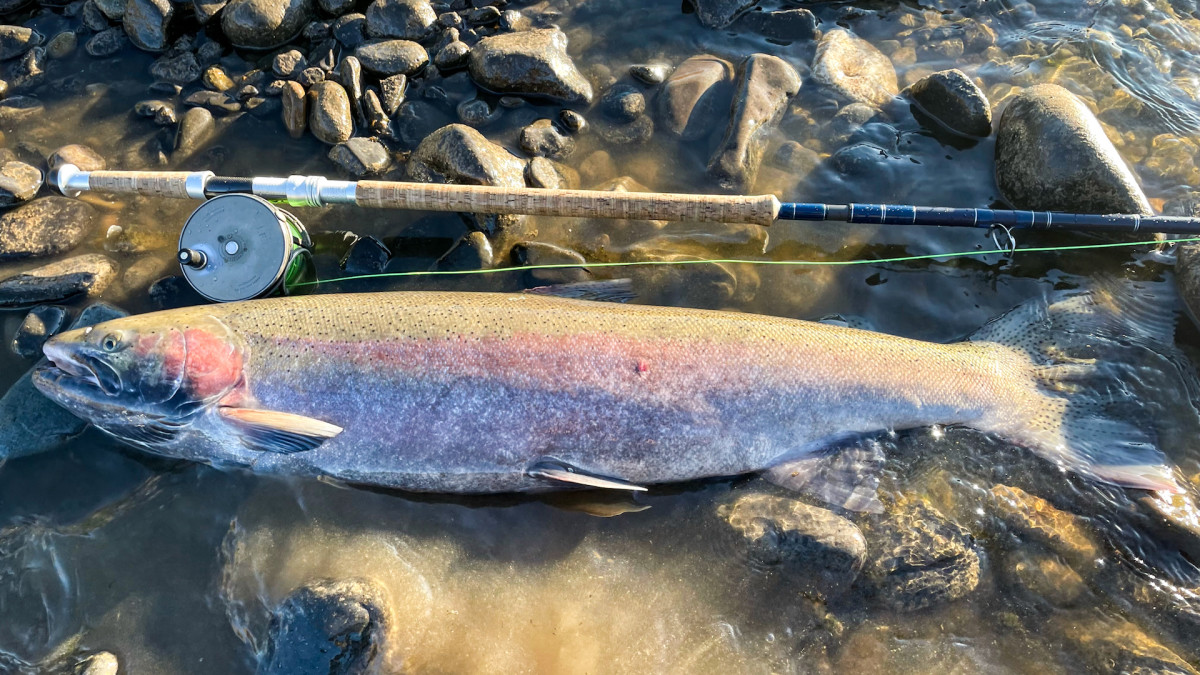
Some rivers are known to hold record fish—and the Clearwater in Idaho is one of them. In October, the river kicked out both a state record steelhead and a coho salmon, just a few days apart. Both anadromous (ocean-going) species make spawning migrations up the Columbia and Snake Rivers before entering the Clearwater on the eastern edge of Idaho, where the species are open to recreational angling.
On October 6, Kyriacos Panayiotou—an angler from McCall—was Spey fishing on the river when something huge grabbed his fly. Spey fishing is a technique first pioneered by Atlantic salmon anglers in England and Scandinavia, but since adapted to Pacific Northwest waters. It entails using a long (usually 13-foot) fly rod to throw a long roll cast into the center of the river. With some proper mending, the line comes taught at a downstream angle, and the fly “swings” broadside across the current toward the bank.
Takes on a swung fly are known to be aggressive, especially with early-fall, warm-water steelhead, and the hit on Panayiotou’s fly was no exception. He was fishing a full-floating line, with the fly trailing just below the surface. “At around 30 degrees of a swing, this beautiful wild steelhead buck boiled to the surface and grabbed the fly with authority,” he told Idaho Fish & Game. “The vintage reel could do nothing in slowing down this fish.”
Panayiotou landed the fish on a gravel bar, measured it on a pocket tape measure, snapped a photo, then released it back into the river. It taped out at 41 inches, beating the previous catch-and-release record by 1.75 inches. The fish, however, was still a few inches shy of the overall 44-inch, 30-pound behemoth caught (and killed) out of the river in 1973.
Steelhead of that caliber are rare, but not unheard of in the Clearwater, which is known for it’s robust “B-run” of steelhead—fish that spend two or three years in the ocean, as opposed to one-salt “A-runs.” According to Clearwater fisheries manager Joe DuPont, the number of steelhead in the 40-plus inch range is less than one percent of the overall run in the average year. His estimate is based on a subsample of migrating fish that are trapped, measured, and then released at Lower Granite Dam on the Oregon-Washington border. This year, of the 261,706 steelhead that were trapped, only four were 41 inches or longer.
But steelhead aren’t the only big fish kicked out of the Clearwater every year. The river also boasts some of the best chinook and coho runs in the state. And on October 13, Matt Hosking of Lewiston nailed what he thought might be a new state-record coho.
He dragged the fish to a nearby grocery store to weigh it on a scale—where it clocked in at 11.78 pounds. It barely eked past the previous record by 0.48 ounces.
Clearwater coho were once completely extinct in the drainage. Although officially declared extirpated in 1985, it’s likely they had already been completely eliminated decades earlier. The current coho run is the result of a hatchery reintroduction program by the Nez Perce tribe beginning in 1994. It wasn’t until 2014, however, that there were enough fish returning for the state to open a recreational fishery. And, according to DuPont the 2023 run was only the third really strong run since the reintroduction program began—2021 and 2022 were the other two.
“There are bigger Coho out there,” DuPont said, “But not many. Based on the 2,400 Coho we have trapped at Lower Granite Dam this year, only two would surpass the size of this fish.”
Hosking is equally as astounded by the catch. “All of my years fishing, I get to finally get my name in the state record books,” he wrote in a Facebook post.
In an era with so many state records still standing from the early- to mid-1900s, it’s easy to forget that record fish are still out there. The Clearwater in Idaho is now fluid-proof that record fish are still swimming—you just have to toss a line in.
Feature image via Idaho Fish and Game Salmon Region Facebook.




